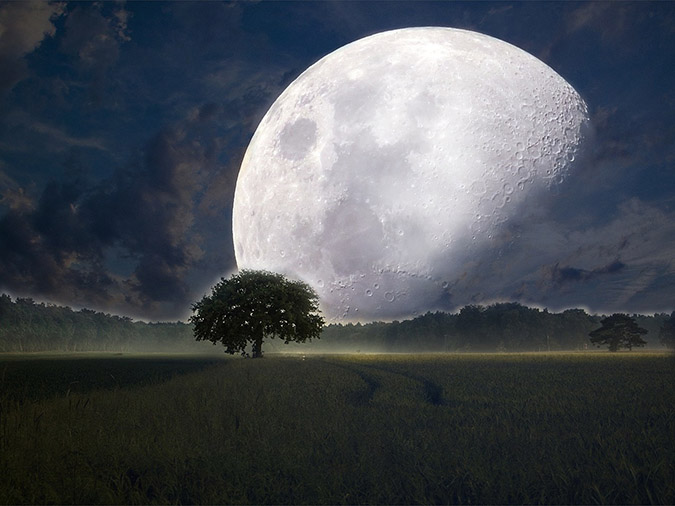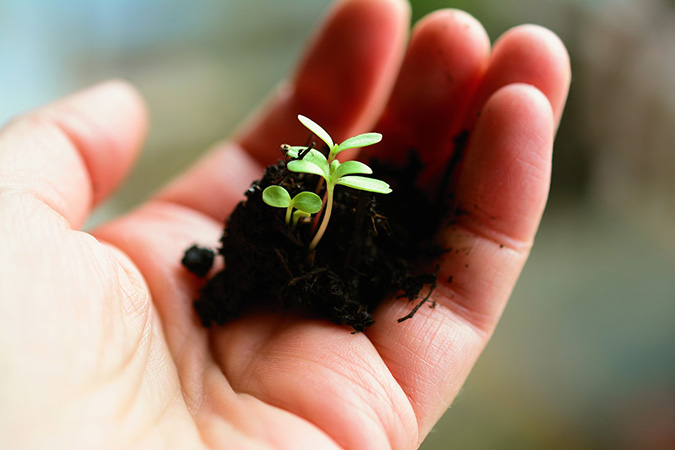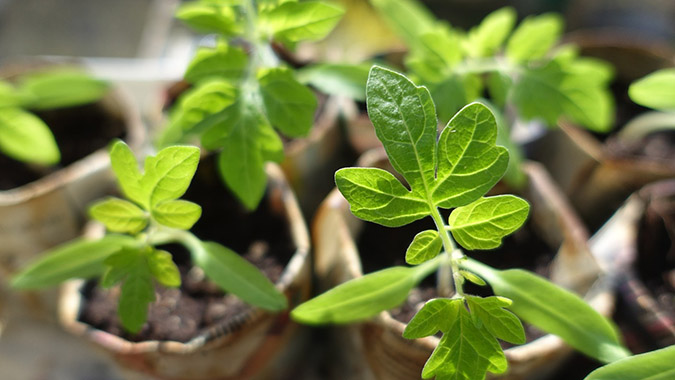Though it’s a controversial practice, many gardeners swear by planting by the moon. Here’s the theory behind it, and 7 tips for success.

Planting by the Moon: Great Idea or Hogwash?
For centuries, gardeners have tried to harness the forces of nature in their quest to achieve the highest possible degree of growing success—whether by using south-facing walls to capture sunlight and create microclimates, digging swales to help rainwater stay in the garden, relying on Mother Nature to break down plant matter into compost … or planting by the moon.
You May Also Enjoy:
“7 Ways to Use Pine Trees for Food and Medicine, Year-round”
Though controversial, this latter idea of using the phases of the moon to guide planting times has been handed down from generation to generation as a useful strategy for those seeking to grow the best food and medicine.
This begs the question: What facts and science do we have to back up these claims?
In truth, the “proof” is mostly anecdotal.
Francis Bacon conducted many experiments in which he planted seeds during various phases of the moon’s cycle. He observed that seeds sown immediately after the new moon (dark moon) produced healthier plants. However, the scientific world didn’t take notice of his discovery.
You May Also Enjoy:
“How to Make A Side Income Selling Seeds: An Interview With Jere Gettle”
Of course, “moon gardeners” aren’t concerned with explaining why the moon affects plants. They are only concerned with stating what they have proven through experience over and over again.
They believe that the positions of the planetary bodies, especially the sun and the moon, match the natural cycle of the universe. Therefore, if we understand these effects and use them to our advantage, we can live in harmony with our world’s natural rhythms.
“… I believe in a dissymmetric cosmic influence which naturally and constantly controls the molecular organization of those principles immediately necessary for life, and that as a consequence, the types of controls of life are, in their structures, forms, and nuclear arrangements, in a relation with the motions of the universe.” ~Louis Pasteur
The Theory Behind Planting by the Moon
The cycles of the moon have influenced gardeners all over the world for centuries. While science doesn’t fully understand why planting by the moon works, experience suggests that it might—or at least that it might be worth trying.
The theory behind moon gardening is that the same gravitational force that creates the tides and brings the sea turtles ashore to lay eggs also cause crops to grow. When the moon wanes, and its light and gravitational pull decreases, the Earth’s gravity kicks in and root crops bear happily in the ground.
However, moon gardeners will warn you not to plant anything on the dark of the moon (new moon). This is the time when plants should rest. It is a good time to kill weeds, because they will not grow back.
7 Tips for Successful Moon Gardening

There are a number of things to keep in mind when planting by the moon:
#1) During a waxing moon, the light increases toward a full moon. This is a great time for sowing and transplanting flowering annuals, biennials, grains, and melons—any short-lived plant that you want to harvest for its leaves, seeds, flowers, or fruits.
It’s also a good time to apply liquid fertilizer, prune, or graft to produce new growth more quickly.
#2) During a waning moon, the light decreases as the moon goes from a full to a new moon. This is the time the energy focuses on the roots, which is a perfect time to plant root crops and perennials.
Apply solid fertilizers and compost at this time. You can also prune dormant plants and harvest. It is less likely that your harvest will rot.
#3) The New moon (from new moon to the first quarter) is best for sowing or transplanting leafy annuals. These are plants like lettuce, spinach, cabbage, and celery, where we value or eat the leaves or stem.
You May Also Enjoy:
“All Hail, Kale! Growing Kale at Home (With Recipe)”
#4) The first quarter phase is most suited to fruiting annuals (not fruit trees) where we value or eat the fruit or seed-bearing part of the plant, like tomatoes, pumpkins, broccoli, and beans.
#5) Full moon (from full moon to the third quarter) is best for sowing or planting root crops, as well as fruiting perennials. Think apples, potatoes, asparagus, rhubarb, etc. You can also take cuttings and divide plants.
#6) In the last quarter phase, avoid planting and focus on improving your soil. Weed, mulch, add compost and manure teas, and create new garden beds. It is also a good time to weed and take care of pests.
Do not sow, plant, or prune 12 hours before or after the transition from one phase to the next.
#7) During a blue moon, which is simply the occurrence of two full moons in one calendar month, plant as you would for any full moon.
The Science Behind Planting by the Moon

When I asked a scientist about planting by the moon, I got a blank stare and a few chuckles. And rightly so.
It’s true. There is very little scientific evidence that planting by the moon has any validity, although there is a growing body of work that shows that the moon does affect plants. One study showed a correlation between the movement of plant leaves and the gravitational pull of the moon, which affects the flow of water through plants.[1]https://www.newscientist.com/article/dn28051-moons-gravity-could-govern-plant-movement-like-the-tides/#:~:text=Planting%20by%20the%20moon,evidence%20to%20back%20this%20up We also know that the plant Ephedra foeminea relies on the lunar cycle for pollination,[2]https://www.newscientist.com/article/dn27277-werewolf-plant-waits-for-the-light-of-the-full-moon although scientists aren’t quite sure how the process works.
Scientists haven’t studied planting by the moon much, because it is believed to be a myth. But given the lack of scientific study, it is certainly possible that there may be some merit to the idea that scientists just haven’t uncovered yet. Given all the anecdotal evidence, I think it would at least be worth a try.
What Do You Think?
Do you garden by the phases of the moon? What are your results? We’d love to hear your stories in the comments below.
_________________
This is an updated version of an article that was originally published on August 21, 2017. The author may not currently be available to respond to comments, however we encourage our Community members to chime in to share their experiences and answer questions!
The Grow Network is a participant in the Amazon Services LLC Associates Program, an affiliate program designed to provide a means for our team to earn fees for recommending our favorite products! We may earn a small commission, at no additional cost to you, should you purchase an item after clicking one of our links. Thanks for supporting TGN!
_________________
Additional Resources:
Planting by the Full Moon. The New York Times. May 2, 1991.
Gardening by the Moon. Farmer’s Almanac.
Solar Eclipse Folklore, Myths, and Superstitions. Farmer’s Almanac.
Moon Planting Guide. January 26, 2015.
Lunar Gardening: The Eclipses, The Planetary Aspects.
Astrological Gardening. Louise Riotte. Storey Communications, Inc.

The Grow Network is a global network of people who produce their own food and medicine. We’re the coolest bunch of backyard researchers on Earth! We’re constantly sharing, discovering, and working together to test new paths for sustainable living—while reconnecting with the “old ways” that are slipping away in our modern world. We value soil, water, sunlight, simplicity, sustainability, usefulness, and freedom. We strive to produce, prepare, and preserve our own food and medicine, and we hope you do, too!

This was interesting indeed!
The early settlers, especially in Pennsylvania where i have some familiarity with the history, consulted the farmer’s almanac religiously.
Pages listed what to plant and when to do it according to the moon’s phases, if one wanted to have abundant crops. In addition, fences ere erected when the points of the moon were up (so the fence would stay up) and shingles on houses were nailed down when the points of the moon were down, to make sure there were no leaks. Timber was always cut on the full moon.
Intrigued. Going to try this, thanks!
I must say I’m hoping it IS a myth – i.e. planting by the moon. It’s so hard for me to get myself to plant anything in the first place, let alone all that thinking about the timing with and without the moon. ( I’d rather make an art piece using embellished fabric collage using plants and/or flowers as my inspiration). To each his own.
Regardless it certainly was an interesting article to read.
Definitely believe that which you stated. Your favorite justification appeared to be on the
net the easiest thing to be aware of. I say to you, I definitely get irked while people consider worries that they plainly don’t know about.
You managed to hit the nail upon the top as well as defined out the whole thing without having side-effects , people can take a signal.
Will likely be back to get more. Thanks
Hi Heather,
Our calendars are a man-made tool originating in Roman politics which we can use for planning; and yes, they’re handy. However, for the purposes of planting and growing in harmony with the cosmos, please consider an alternative definition for the blue moon.
With regard to planting in harmony with the moon, the definition of a “blue moon” would not be based upon a calendar month, but rather upon an occasion when two consecutive full moons occur within the same zodiac sign. This happens much less frequently than the calendar month coincidence. Note that some sources define the blue moon as the fourth full moon within a given season, which happens regularly about every 2.7 years.
Each full moon occurs 29.5 days apart, usually resulting in one per month. In order for a blue moon to occur, the first full moon must happen very early in the sign, and the second very late in the same sign. Using this definition, the most recent blue moon was in June of 2016, and the next one coming up will be in April of 2019.
The timings, as you stated, should still be in harmony with the phases of the moon and the signs through which it’s traveling, as for a regular moon cycle.
One reason would be the moonlight itself. Any home sprouter knows you start seeds in darkness, more or less, and then when they sprout and the roots grow an inch or so, then the shoots start. Shoots need light. you put your sprouts in the sun then. It would make sense that the plant would be strongest started in darkness with the shoot starting around the second quarter for plenty of early light.
The other claims need some other explanation. Facts are facts whether we understand them or not. Real science isn’t pooh-poohing in ignorance, nor is it politically correct claims. It is taking a careful look to find out.
I read once that millionaires do not use astrology. Billionaires do.
Most of us spend so much time and energy starting our seeds and planting our gardens… why not planting according to the moon cycle? It doesn’t take more time or energy to do so and it might help!
I tried planting by the moon for a few years and didn’t see much difference. Honestly, here in the Pacific NorthWET it is tricky to find a good time to plant at all when the rain is not pouring down. Having to time it by the moon just added stress. (Maybe my plants sensed the stress!)
Rudolf Steiner has the best guide on planting by the moon, it is a daily chart put out yearly, for planting root, leaf, flowering and I forget the 4th category of plant. Am in Central America, and cutting wood or bamboo certainly makes a difference if it is done during the waning or waxing of the moon, as it will rot quicker or preserve or grow quicker. We did our huge fence this way with great success.
I was raised in Pennsyvania and my mom was the daughter of a German Dutch farmer and she planted by the moon AND by the snows…..each Spring we had a Lettuce snow, an onion snow and a Pea snow